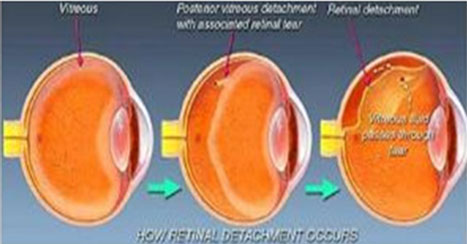Retinal Detachment is separation of 9 lasers of neurosensory retina from underlying retinal pigment epithelium, which causes profound visual loss. To know the details, scroll down.
WHAT CAUSE RETINAL DETACHMENT?
Most retinal detachments are caused by presence of one or more retinal holes or tears. Normal retina can develop holes due to ageing.
Normally vitreous is attached to the retina at several places. As the vitreous shrinks it causes tear or hole in retina and liquefied vitreous passes through hole and detaches retina from its normal position.

Posterior vitreous detachment is normal ageing process; however, it can occur at an earlier age in -
- High myopic peoples (High minus spectal number)
- History of cataract surgery
- Any ocular trauma
WHAT ARE THE SYMPTOMS OF RETINAL DETACHMENT?
Most retinal detachments are caused by presence of one or more retinal holes or tears. Normal retina can develop holes due to ageing.
Normally vitreous is attached to the retina at several places. As the vitreous shrinks it causes tear or hole in retina and liquefied vitreous passes through hole and detaches retina from its normal position.
Posterior vitreous detachment is normal ageing process; however, it can occur at an earlier age in
- Patients may notice floaters and of flashes of light
- Appearance of dark shadow in some part of side vision
- As the retinal detachment advances, there is blurring of central vision and significant diminution of vision unless operated.
HOW TO DIAGNOSE?
If above symptoms are noticed, immediately visit ophthalmologist. Detailed examination of retina by binocular indirect ophthalmoscope and or Ultrasound B scan is must.
TREATMENT OF RETINAL DETACHMENT
- Scleral buckling
- Vitrectomy
- Pneumoretinopexy